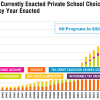This updates an earlier post.
Border Patrol Chief Jason Owens confirmed last week that the number of known successful evasions of Border Patrol (“gotaways”) have fallen to just 800 per day in fiscal year 2024—down 70 percent from 2,671 the week before the Title 42 expulsion authority ended on May 11. A decline in gotaways this large and fast is unprecedented in Border Patrol’s history, and even as the administration faces unrelenting criticism, this stands as a major immigration win.
I have previously written about this phenomenon, using numbers leaked by Border Patrol to friendly journalists who report them without the context of the broader trend. But this update confirms that the low numbers continued into January and February. Figure 1 shows the monthly data using the chief’s update and media reporting for more recent numbers and a Freedom of Information Act for the older numbers. Gotaways fell from a high of 73,463 in April 2023 just before Title 42 ended to about 21,758 in February 2024. Ending Title 42 appears to have been the biggest single benefit to border security in its history.
Interestingly, the decline in gotaways has persisted even when the number of arrests has increased. Getting rid of Title 42 without letting people come legally was never going to change every aspect of the situation, but it has not made the situation worse. From the standpoint of border security, the situation has improved dramatically because fewer people are escaping screening by the Border Patrol. This means Border Patrol can more effectively screen out criminals. Moreover, contrary to the apocalyptic claims about ending Title 42, the average number of Border Patrol arrests has not increased.
Figure 3 shows the “gotaway” rate—that is, the share of gotaways out of all arrests and gotaways. This is a rough approximation of Border Patrol effectiveness, controlling for the total inflow. As it shows, since Title 42 ended, the gotaway rate has fallen dramatically to below 14 percent, the lowest level outside of a couple months in 2019. This is a return to the trend under the Obama administration in reducing the rate of successful crossings. Every month since August 2023 has been below 15 percent—the longest such period on record. According to the Rio Grande Valley sector chief, this trend of low gotaway rates continued in that sector into March, and Fox News is reporting a low rate nationwide in March as well.
None of this should be a surprise. In our amicus brief outlining reasons to be skeptical of claims that Title 42 would cause a surge in illegal crossings, we explained that Border Patrol’s practice of placing people back on the other side of the border incentivized illegal crossings by giving individuals repeated chances to enter illegally. It also motivated people who would otherwise turn themselves in for asylum to slip in covertly.
Gotaway data have become more reliable over the past decade because border surveillance has increased dramatically from 2005 to 2023. Now, nearly the entire border has some form of electronic surveillance at all times. Moreover, the Obama administration made efforts to systematize the criteria for recording a gotaway to make the measure more consistent and reliable in 2014. Additionally, communication between stations was improved to remove double counting.
CBP also estimates the successful crossing rate using surveys of deportees. It first estimates the total flow of deportees returning to the US border based on surveys conducted by Colegio de la Frontera Norte International Border Survey. It then subtracts the number of deportees that it arrested and assumes the remainder escaped detection. Of course, some do attempt to reenter when they initially indicated no intention to do so, and some do not attempt to reenter when they said they did. CBP has made additional efforts to account for individual characteristics of crossers to resolve some of this problem.
While the model‐based estimates are certainly not perfect, these data show that CBP’s observational data (gotaways) are improving compared to the models. Figure 4 compares the observational apprehension rates to the model‐based rates. It shows that the observational data converged with the model‐based data around 2014. From that point on, the observational gotaway data accounted for between 75 percent and 100 percent of modeled gotaways.
Although the gap between observational and modeled estimates was the largest in 2020 since 2014, observational gotaways still accounted for about 75 percent of modeled gotaways. 2020’s decline in modeled effectiveness likely reflects that people’s intentions changed in response to the pandemic and fewer people tried to enter illegally than the model predicted. There was no observed increase in gotaways during fiscal year 2020, which ended in October (though there was a dramatic increase by December 2020).
The United States has a legitimate interest in regulating the entry of serious criminals and other threats to Americans, and border security is a significant component of that effort. Ending Title 42 improved border security and reduced successful illegal entries. This should force the many members of Congress and the administration who opposed ending Title 42 to rethink their position.
























